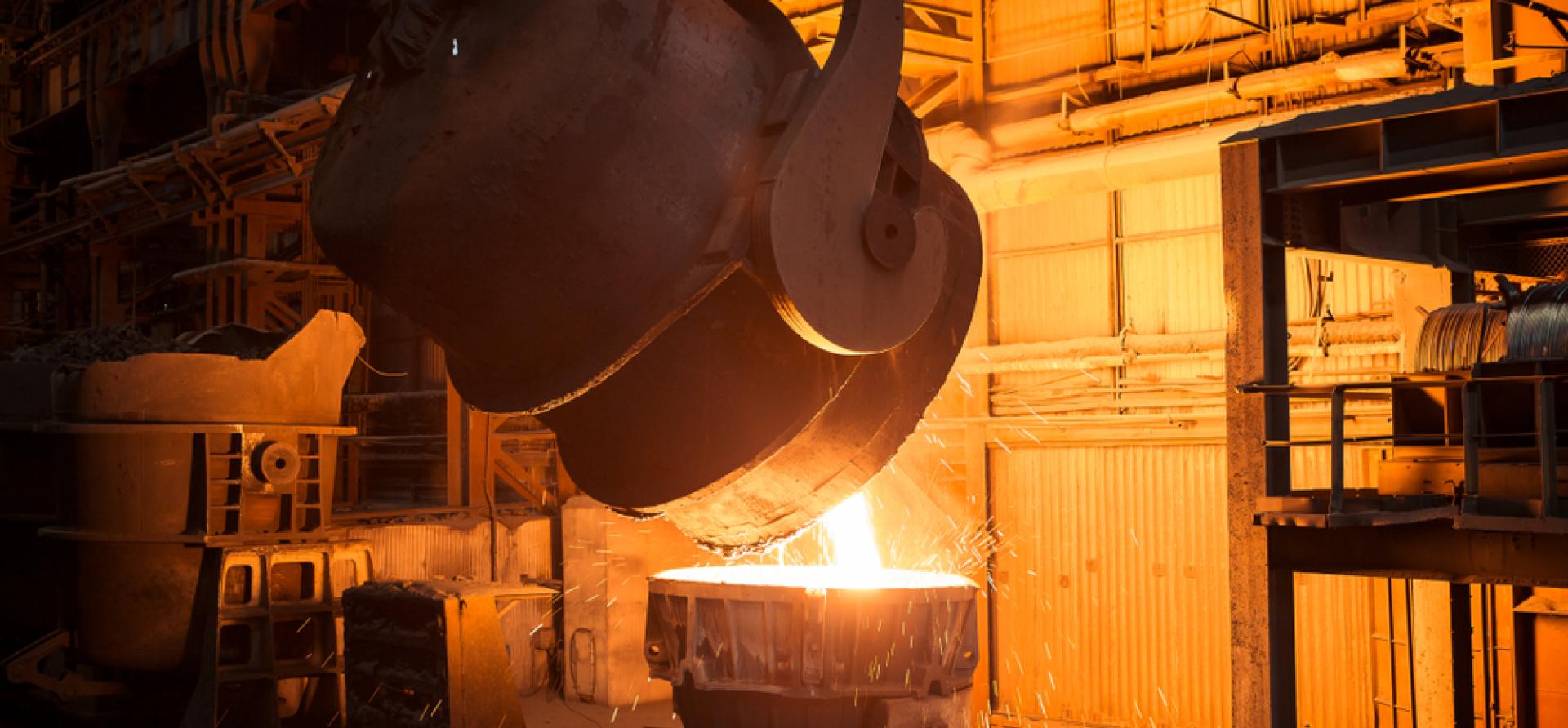
Key Findings
We expect green hydrogen to become the primary route of steelmaking in India only by 2050. This is because the cost of green hydrogen needs to reduce and there needs to be a price penalty on carbon emissions for Indian steelmakers to switch to hydrogen-based steelmaking.
A legal definition for green steel can help guide the industry in making the right investments for decarbonisation.
Strict enforcement of renewable purchase obligations on the steel sector can also help in the greater use of clean energy in the steel sector.
IEEFA and JMK Research estimate that the steel industry will replace around 25-30% of its grey hydrogen requirements with green hydrogen in the early part of the 2030-2050 period. This will increase to 80% by 2050.
Executive Summary
In India, the steel industry contributes to around 2% of the Gross Domestic Product (GDP) and is critical to the country’s progress. In the fiscal year (FY) 2023, the production of finished steel in India was 122.3 million tonnes, an increase of about 7.6% over the previous year.
India’s steel sector accounts for about 12% of India’s carbon dioxide (CO2) emissions, with an emission intensity of 2.55 tonne of CO2/tonne of crude steel (tCO2/tcs) compared with the global average emission intensity of 1.85 tCO2/tcs. The steel industry is responsible for around 240 million tonnes of CO2 emissions annually and we expect this to double at an exponential rate by 2030, considering the Indian government’s infrastructure development targets.
There are multiple technology pathways that could help in the transition from traditional methods to low emission intensity technology like green hydrogen, renewable energy, carbon capture, usage and storage technology with Blast Furnace (BF)/Basic Oxygen Furnace (BOF) or Direct Reduced Iron (DRI)-Electric Arc Furnace (EAF), scrap-based Electric Arc Furnace (EAF) etc. Of these technologies, the green hydrogen-based route is the cleanest method of producing steel. However, green hydrogen is expensive and investing in the technology could render steelmakers uncompetitive as they sell a highly commoditised product.
The government has taken initiatives to decarbonise the steel sector, including the Steel Scrap Recycling Policy 2019, the Perform, Achieve and Trade (PAT) scheme and the announcement of 13 task forces by the Ministry of Steel for developing a green steel roadmap.
The most important initiative though is the National Green Hydrogen Mission (NGHM), under which the Ministry of Steel has been allocated 30% of the pilot project budget, i.e., Rs14.66 billion (US$177 million), to promote the use of green hydrogen in steelmaking.
Under this mission, the Solar Energy Corporation of India (SECI) has issued two tenders under Strategic Interventions for the Green Hydrogen Transition (SIGHT) programme in July 2023. The first is a 1.5 gigawatts (GW) tender for scaling up localised manufacturing in the electrolyser space, and research and development in indigenous stack technology. The second tender is for producing 450,000 tonnes of green hydrogen per annum on technology-agnostic and biomass pathways. The tenders are aimed at bringing down the price of green hydrogen.
To switch from coal-based steelmaking to hydrogen, the cost of green hydrogen needs to reduce and there needs to be a price penalty on carbon emissions.
For Indian steelmakers to switch from coal-based steelmaking to hydrogen-based steelmaking, the cost of green hydrogen needs to reduce and there needs to be a price penalty on carbon emissions.
According to industry estimates, to make hydrogen technology viable for expansion, the required price should be around US$1-2/kg and a carbon penalty of at least US$50 per tonne of emissions should be applicable on steel manufactured through traditional methods. This can make green steel competitive and catalyse a 150 million tonne shift from coal-based to hydrogen-based steelmaking.
Based on our analysis, we expect India’s steel sector decarbonisation trajectory until 2070 to be the following:
- Up to 2030: The sector is likely to see a reduction in the share of coal-based technologies, i.e., BF/BOF and coal-based EAF/Electric Induction Furnace (EIF) route from 92% in 2021 to 70% by 2030. This transition is possible by replacing coal-based EAF technologies with green hydrogen. Several pilot projects and trials for green hydrogen projects started in India in 2020. By 2030, green hydrogen production is likely to start on a commercial scale in India.
- 2030 to 2050: In this period, green hydrogen projects will be deployed on a large scale across India due to high demand. This is likely to phase out coal-based routes like BF/BOF and DRI-EAF at a faster pace. IEEFA and JMK Research estimate that the steel industry will replace around 25-30% of its grey hydrogen requirements with green hydrogen. This will increase to 80% by 2050.
- From 2050-2070: During this time, large projects using the green hydrogen-based route will be available across India, and the cost of green hydrogen will be significantly reduced due to a highly competitive market. The green hydrogen-based route is, therefore, likely to completely replace coal and natural gas-based conventional technology.
As low-emission technologies like green hydrogen become economically feasible, funding to support Micro, Small and Medium Enterprises (MSMEs) will also start coming into the sector. This funding will be in the form of loans, bonds or schemes that are tailor-made for the steel sector. Such instruments include sustainability-linked bonds and loans (SLBs and SLLs) and blended finance mechanisms.
Development in any sector brings opportunities and challenges at the same time, and so is the case with the steel sector. The steel sector has its own set of challenges on the technical and commercial fronts. To address these challenges, policymakers need to think of innovative steps that will aid the decarbonisation of the steel sector.
IEEFA and JMK Research have identified some policy actions that can accelerate the decarbonisation of India’s steel sector. One of the key policy decisions that the government needs to take is to define green steel. Currently, there is no legal definition for green steel in India, and without it, the technology track that the industry should follow remains unclear. We recommend that the government define green steel as steel that does not use fossil fuels in the production process. All other technologies that reduce emissions should be termed low-carbon steel.
We note that the government has recognised the need for a clear taxonomy for green steel and has set up a task force for developing a taxonomy, definitions, benchmarks, scoping and certifications
for it.
Steel remains a highly commoditised product and the high cost of green steel implies that there is insufficient demand for it in the absence of policy action. We recommend that the government look at mandating some quantity of green steel in public sector purchases. It can also extend the mandate to private consumers. For creating demand in the private sector, the government can also look at using Green Steel Certificates, which consumers of green steel can trade for additional income through trading on the carbon market.
At the same time, policies should also look at progressively penalising steel produced from traditional high-emission technologies.
At the same time, policies should also look at progressively penalising steel produced from traditional high-emission technologies. This will help bridge the gap between the prices of green steel and traditionally produced steel.
Finally, to ensure sustained investments in green hydrogen production, which can bring down its cost, the government can look at introducing a green hydrogen purchase obligation mechanism for the steel sector. This will ensure there is demand for green hydrogen and steelmakers invest in green hydrogen-based technologies. Similarly, strict adherence to renewable purchase obligations can also help in the greater use of clean energy in the steel sector.
We believe that with the right policies in place, India can successfully decarbonise its steel sector by 2070.
(Corrigendum: A previous version of the report had incorrectly referred to electric arc furnace (EAF) as a coal-based technology. The report has now been updated with the correct terminology, "coal-based direct reduced iron (DRI)-EAF route". We regret the error.)



















